(完整版)新概念第一册语法讲解:现在完成时
新概念一现在完成时

例子:I have lived in Beijing since 2010.
与already, just, yet等副词连用
用于肯定句中, 强调动作已经完 成
用于疑问句中, 表示对动作是否 完成的疑问
与just连用,表 示刚刚完成某动 作
与yet连用,表示 动作尚未完成
汇报人:XX
现在完成时强调对现 在产生的影响或结果, 而一般过去时只表示 过去的动作或状态。
现在完成时可以与表 示一段时间的状语连 用,而一般过去时通 常不与时间状语连用。
现在完成时可以表示过 去的动作对现在的影响 ,而一般过去时只能表 示过去的动作或状态。
现在完成时可以表示从 过去某个时间点到现在 为止的动作或状态,而 一般过去时只表示过去 的动作或状态。
去分词
例子:I have finished my homework. (我 已经完成了作业, 现在不需要再做 了)
过去动作和现在的关系
定义:现在完成时表示过去发生的动作或情况对现在的影响或结果
用法:常与already, yet, just等副词连用,表示动作发生在过去,但与现在的情况有 关
结构:have/has + 过去分词
XX,a click to unlimited possibilities
汇报人:XX
目录
过去动作对现在的影响
定义:现在完成 时表示过去发生 的动作或情况对 现在的影响或结 果
用法:常与 already, yet, just等副词连用, 表示动作发生在 过去,但与现在 仍有联系
结
构
:
have/has + 过
现在完成时可以与表示过去的时间 状语连用,强调过去发生的动作和 现在的联系。
新概念英语第一册全部语法
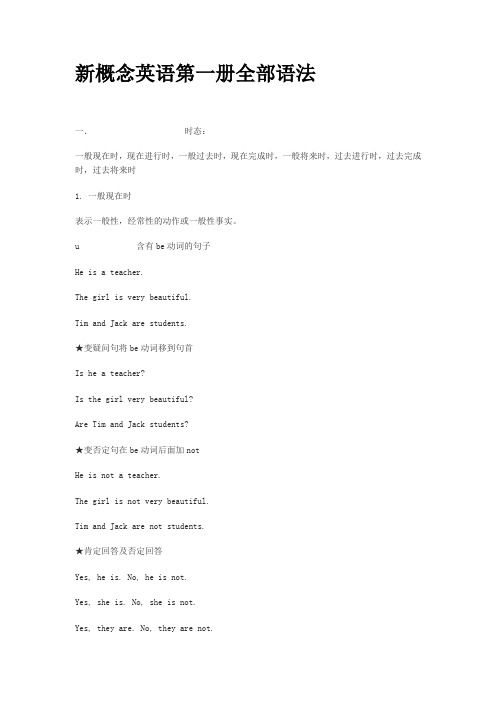
新概念英语第一册全部语法一.时态:一般现在时,现在进行时,一般过去时,现在完成时,一般将来时,过去进行时,过去完成时,过去将来时1. 一般现在时表示一般性,经常性的动作或一般性事实。
u 含有be动词的句子He is a teacher.The girl is very beautiful.Tim and Jack are students.★变疑问句将be动词移到句首Is he a teacher?Is the girl very beautiful?Are Tim and Jack students?★变否定句在be动词后面加notHe is not a teacher.The girl is not very beautiful.Tim and Jack are not students.★肯定回答及否定回答Yes, he is. No, he is not.Yes, she is. No, she is not.Yes, they are. No, they are not.u 不含有动词的句子,即含有一般动词的句子第三人称单数及单数名词He likes books.She likes him.The dog likes bones.★变疑问句在句首加does, 动词变为原型Does he like books?Does she like him?Does the dog like bones?★变否定句在主语及动词之间加doesn’t, 动词变为原型He doesn’t like books.She doesn’t like him.The dog doesn’t like bones.★肯定回答及否定回答:Yes, he does. No, he doesn’t.Yes, she does. No, she doesn’tYes, it does. No, it doesn’t.注意:第三人称单数形式一般在动词后面加S,不要和名词复数混淆,变否定句或疑问句时名词复数没有任何变化。
(完整版)新概念英语第一册lesson85-86重点解析
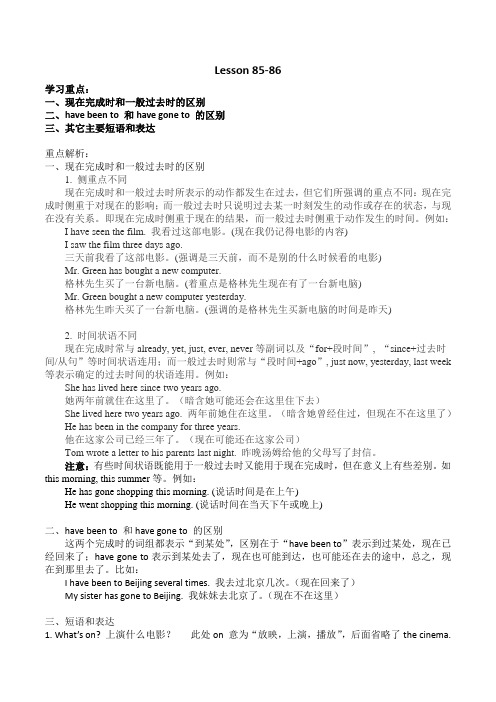
Lesson 85-86学习重点:一、现在完成时和一般过去时的区别二、have been to 和have gone to 的区别三、其它主要短语和表达重点解析:一、现在完成时和一般过去时的区别1. 侧重点不同现在完成时和一般过去时所表示的动作都发生在过去,但它们所强调的重点不同:现在完成时侧重于对现在的影响;而一般过去时只说明过去某一时刻发生的动作或存在的状态,与现在没有关系。
即现在完成时侧重于现在的结果,而一般过去时侧重于动作发生的时间。
例如:I have seen the film. 我看过这部电影。
(现在我仍记得电影的内容)I saw the film three days ago.三天前我看了这部电影。
(强调是三天前,而不是别的什么时候看的电影)Mr. Green has bought a new computer.格林先生买了一台新电脑。
(着重点是格林先生现在有了一台新电脑)Mr. Green bought a new computer yesterday.格林先生昨天买了一台新电脑。
(强调的是格林先生买新电脑的时间是昨天)2. 时间状语不同现在完成时常与already, yet, just, ever, never等副词以及“for+段时间”, “since+过去时间/从句”等时间状语连用;而一般过去时则常与“段时间+ago”, just now, yesterday, last week 等表示确定的过去时间的状语连用。
例如:She has lived here since two years ago.她两年前就住在这里了。
(暗含她可能还会在这里住下去)She lived here two years ago. 两年前她住在这里。
(暗含她曾经住过,但现在不在这里了)He has been in the company for three years.他在这家公司已经三年了。
(现在可能还在这家公司)Tom wrote a letter to his parents last night. 昨晚汤姆给他的父母写了封信。
(完整版)现在完成时讲解
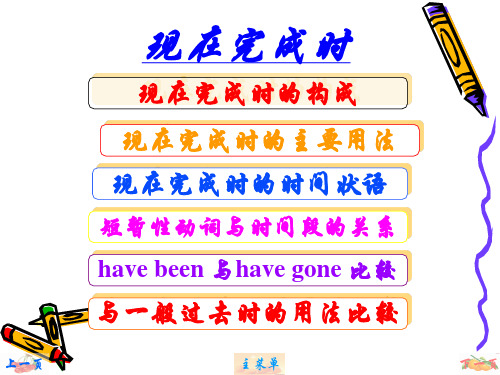
I have had this watch for five years / since 5 years ago.
2.这位老人已经死了十年了。
WThe old man has died for ten years.
The old man has been dead for ten years/since 10 years ago.
I have learnt English for more than ten years.我已经学了10多年的英语。
(从10年前开始,持续到现在还在学)
上一页
She has swum since half an hour ago. 我已经游泳了半个小时
(半个小时前已经开始游泳,到现在还在游)
主菜单
于助动词或系动词后,实义动词前。 • never用于句中,助动词或系动词后,实
义动词前,表示否定意义。
• He has ever been to Paris.
• He has never been to Paris.
3) just表示“刚刚”(用于完成时态时,与already, never 等副词的位置一样,多用在助动词have/has和 动词过去分词之间)
He has been here for three days.
He has been here since yesterday.
He has been here since two days ago / last Monday.
He has been here since his wife died.
Since he was a child ,he has lived in England.
新概念英语第一册第83课现在完成时(共28张PPT)
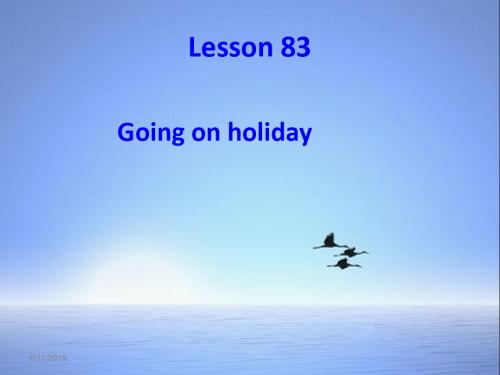
The movie fans packed the hall. 公共汽车里挤满了人。
The bus is packed with people.
★leave v. 离开
① v. 离开,出发
火车还有5分钟就开了。
The train is leaving in 5 minutes.
Have you had your breakfast yet ?
Lesson 83
Going on holiday
Q:Where did Sam go for his holiday this year?
课文讲解
1. Have实义动词 吃早饭 Have breakfast 抽根烟 Have a cigarette 洗个澡 Have a bath 喝杯橙 Have a glass of orange juice
let’s后面要用动词原形。 let’s 包括对方。例如: Let’s go! Let’s have some tea. let us 不包括对方。例如: Mum, please let us play football. 注意:let’s have some tea, shall we? 我们一起喝茶怎么样? Let us go home, will you? 你回家吧,怎么样?
5.Have a glass of whisky . 6.我们去了一家饭店
6.We went to a restaurant. 7.怎么了?出了什么事?
6/171/2.0W19 hat's the matter?
Have a dictation 听写
have(take) a bath take a shower give sb a bath a bath of sunshine bath roast nearly ready dinner restaurant
新概念英语第一册语法解析:现在完成时
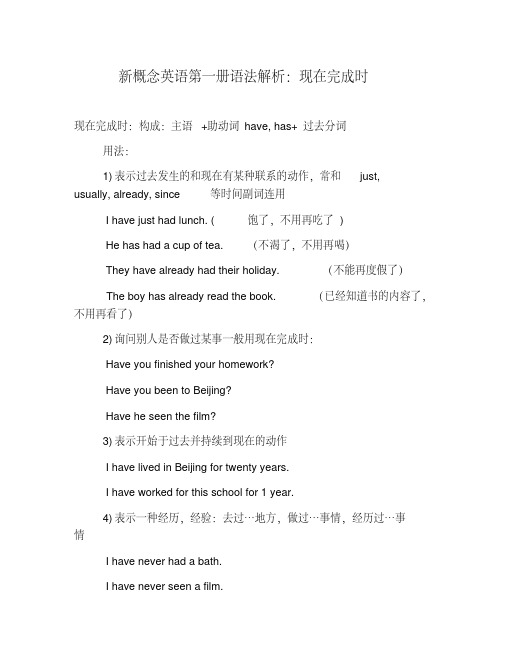
新概念英语第一册语法解析:现在完成时现在完成时:构成:主语+助动词have, has+过去分词用法:1)表示过去发生的和现在有某种联系的动作,常和just, usually, already, since等时间副词连用I have just had lunch. (饱了,不用再吃了)He has had a cup of tea.(不渴了,不用再喝)They have already had their holiday. (不能再度假了)The boy has already read the book. (已经知道书的内容了,不用再看了)2)询问别人是否做过某事一般用现在完成时:Have you finished your homework?Have you been to Beijing?Have he seen the film?3)表示开始于过去并持续到现在的动作I have lived in Beijing for twenty years.I have worked for this school for 1 year.4)表示一种经历,经验:去过…地方,做过…事情,经历过…事情I have never had a bath.I have never seen a film.I have never been to cinema.I have ever been to Paris.Have been to表示去过,have gone to 表示去了I have been to London.(人已经回来)He has gone to London.(人还在那里)5)表示一种结果,一般不和时间副词联用I have lost my pen.I have hurt myself.He has become a teacher.She has broken my heart.句型变化:变疑问句将助动词移到句首,变否定句在助动词后面加not.e.g. Have you lost your pen? I have not lost my pen.肯定回答及否定回答Yes, I have. No, I have not.特殊疑问句:What have you done?What has he done?一般过去时与现在完成时的区别:凡是有明确的表示过去的时间状语的句子为过去时注意:有些动词表示的动作有一个终点,不能再延续,所以不能和表示一段时间状语连用错:I’ve left Beijing for 3 days.对:I left Beijing 3 days ago. I have been away frombeing for 3 days.。
新概念英语第一册语法总结八种时态句型和语法
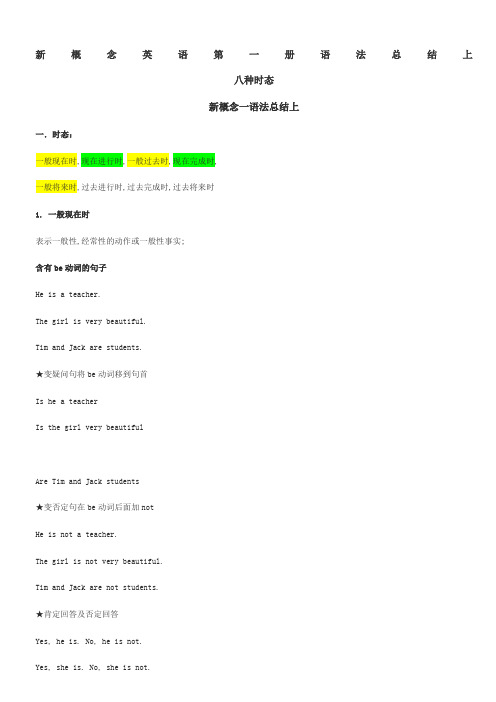
新概念英语第一册语法总结上八种时态新概念一语法总结上一.时态:一般现在时,现在进行时,一般过去时,现在完成时,一般将来时,过去进行时,过去完成时,过去将来时1.一般现在时表示一般性,经常性的动作或一般性事实;含有be动词的句子He is a teacher.The girl is very beautiful.Tim and Jack are students.★变疑问句将be动词移到句首Is he a teacherIs the girl very beautifulAre Tim and Jack students★变否定句在be动词后面加notHe is not a teacher.The girl is not very beautiful.Tim and Jack are not students.★肯定回答及否定回答Yes, he is. No, he is not.Yes, she is. No, she is not.Yes, they are. No, they are not.不含有动词的句子,即含有一般动词的句子第三人称单数及单数名词He likes books.She likes him.The dog likes bones.★变疑问句在句首加does, 动词变为原型Does he like booksDoes she like himDoes the dog like bones★变否定句在主语及动词之间加doesn’t, 动词变为原型He doesn’t like books.She doesn’t like him.The dog doesn’t like bones.★肯定回答及否定回答:Yes, he does. No, he doesn’t.Yes, she does. No, she doesn’tYes, it does. No, it doesn’t.注意:第三人称单数形式一般在动词后面加S,不要和名词复数混淆,变否定句或疑问句时名词复数没有任何变化;其他人称及复数名词I want to have a bath.We have some meat.The students like smart teachers.★变疑问句在句首加doDo you want to have a bathDo we have any meatDo the students like smart teachers★变否定句在主语和动词之间加don’t.You don’t want to have a bath.We don’t have any meat.The students don’t like smart teachers.★肯定回答及否定回答Yes, I do. No, I don’t.Yes, we do. No, we don’tYes, they do. No, they don’t.2.现在进行时表示现在正在进行的动作;构成:主语+be动词+动词的现在分词+其它成分现在分词的构成见附录We are having lunch.He is reading a book.The dog is running after a cat.The boys are swimming across the river.★变疑问句将be动词移到句首Are we having lunchIs he reading a bookIs the dog running after a catAre the boys swimming across the river★变否定句在be动词后面加 notWe are not having lunch.He is not reading a book.The dog is not running after a cat.The boys are swimming across the river.★特殊疑问句:what, which, how, where, who, etc.疑问词+动词+主语+现在分词What are you doingWhat is she doingWhat is the dog doing必背没有进行时的动词表示状态,思想,感情和感觉的动词不能表示正在进行的动作1. 表示感觉,感官的词see, hear, like, love, want,2. have, has当”拥有”讲时没有进行时3.一般过去时表示过去发生的动作或事件,常和表示过去的时间状语连用,如yesterday, last night, the day before yesterday, 3 days ago,含有be动词的句子,将动词变为过去式,am, is的过去式为was,are的过去式为wereI was at the butcher’s.You were a student a year ago.The teacher was very beautiful ten years ago.★变疑问句将be动词移动到句首Were you at the butcher’sWere you a student a year agoWas the teacher very beautiful ten years ago★变否定句在be动词后面加notI was not at the butcher’s.You were not a student a year ago.The teacher was not very beautiful ten years ago.★肯定回答否定回答Yes, I was. No, I was not.Yes, you were. No, you were not.Yes, he/she was. No, he/she was not.★特殊疑问句:What did you do必背不含有be动词的句子,将动词变为过去式,动词过去式构成见附录I finished my homework yesterday.The boy went to a restaurant.The Sawyers lived at King Streeta year ago.King Streeta year ago.★变疑问句在句首加did,动词变为原型Did you finish your homework yesterdayDid the boy go to a restaurantDid the Sawyers live at King Streeta year agoKing Streeta year ago★变否定句在主语和动词之间加did notI did not finish my homework yesterday.The boy did not go to a restaurant.The Sawyers did not live at King Streeta year ago.King Streeta year ago.★肯定回答及否定回答Yes, I did. No, I didn’t.Yes, he did. No, he didn’t.Yes, they did. No, they did not.4.现在完成时构成:主语+助动词have, has+过去分词用法:1表示过去发生的和现在有某种联系的动作,常和just, usually, already, since等时间副词连用I have just had lunch. 饱了,不用再吃了He has had a cup of tea.不渴了,不用再喝They have already had their holiday. 不能再度假了The boy has already read the book. 已经知道书的内容了,不用再看了2询问别人是否做过某事一般用现在完成时:Have you finished your homeworkHave you been to BeijingHave he seen the film3表示开始于过去并持续到现在的动作I have lived in Beijing for twenty years.I have worked for this school for 1 year.4表示一种经历,经验:去过…地方,做过…事情,经历过…事情I have never had a bath.I have never seen a film.I have never been to cinema.I have ever been to Paris.Have been to表示去过,have gone to表示去了I have been to London.人已经回来He has gone to London.人还在那里5表示一种结果,一般不和时间副词联用I have lost my pen.I have hurt myself.He has become a teacher.She has broken my heart.句型变化:★变疑问句将助动词移到句首,变否定句在助动词后面加not.e.g. Have you lost your pen I have not lost my pen.★肯定回答及否定回答Yes, I have. No, I have not.★特殊疑问句:What have you doneWhat has he done一般过去时与现在完成时的区别:凡是有明确的表示过去的时间状语的句子为过去时注意:有些动词表示的动作有一个终点,不能再延续,因此不能和表示一段时间状语连用错:I’ve left Beijing for 3 days.对:I left Beijing 3 days ago. I have been away from being for 3 days.5.一般将来时表示将来将要发生的动作,经常和tomorrow, next year, the day after tomorrow, the year after the next, in five hours’ time, etc. 表示将来的词联用结构:主语+助动词will+动词原形I will go to America tomorrow.The pilot will fly to Japan the month after the next.Jack will move into his new house tomorrow morning.★变疑问句将助动词移到句首Will you go to America tomorrowWill the pilot fly to Japan the month after the nextWill Jack move into his new house tomorrow morning★变否定句在助动词后面加notI will not go to America tomorrow.The pilot will not fly to Japan the month after the next.Jack will not move into his new house tomorrow morning★肯定回答及否定回答Yes, I will. No, I will not.Yes, he/she will. No, he/she will not.Yes, he will. No, he will not.★特殊疑问句:What will you do6.过去完成时:用法:在过去的时间里,两个动作中,发生在前的哪个动作要用过去完成时;结构:had+过去分词After she had finished her homework, she went shopping.They had sold the car before I asked the price.The train had left before I arrived at the station.After/before引导的时间状语从句放在句首要在句子后面加逗号,如果放在主句后则不用加; ★变疑问句将助动词移到句首Had she finished her homework★变否定句在助动词后面加notShe hadn’t finished her homework.★肯定回答及否定回答Yes, she had. No, she hadn’t.★特殊疑问句:What had she done7.过去进行时表示过去正在进行的动作,经常用在when, while, as引导的状语从句中;结构:was/were+doingWhen my husband was going into the dining room this morning, he dropped some coins on the floor. While we were having dinner, my father was watching TV.8.过去将来时结构:would doShe said she would go here the next morning.二.特殊句型:there be句型,be going to结构1. Be going to结构表示打算,准备,计划做某事★结构:主语+be动词+going to +动词原型I am going to make a bookcase.They are going to paint it.The father is going to give the bookcase to his daughter.★变疑问句将be动词移到句首Are you going to make a bookcaseAre they going to paint itIs the father going to give the bookcase to his daughter★变否定句在be动词后面加notI am not going to make a bookcase.They are going to paint it.The father is not going to give the bookcase to his daughter.★肯定回答及否定回答Yes, I am. No, I am not.Yes, they are. No, they are not.Yes, he is. No, he is not.★特殊疑问句What are you going to doWhat are they going to doWhat is the father going to do必背2. There be句型表示哪里有什么东西某处有某物There is+单数名词+表示场所的词一般为介词词组There is a book in this room.There is a pen on the tableThere are+复数名词+表示场所的词一般为介词词组There are two pens on the table.There are three schools there.★变疑问句将be动词移到句首Is there a book in this roomAre there two pens on the table★变否定句在动词后面加notThere is not a book in this room.There are not two pens on the table.★肯定回答及否定回答Yes, there is. No, there is not.Yes, there are. No, there are not.一般疑问句,特殊疑问句,选择疑问句,反意疑问句,选择疑问句,否定疑问句2 一般疑问句: 助动词/be动词+主语Are you a teacher Do you want to have a cup of tea2 特殊疑问句: 特殊疑问词+一般疑问句What is your name2 选择疑问句: orDo you want beef or lamb2 反意疑问句: 肯定陈述句+否定疑问部分,否定陈述部分+肯定疑问部分You don’t need that pen, do you2 否定疑问句: 一般疑问句+否定词Aren’t you luckyDon’t you want have a rest四.冠词用法:a/an/the的一般用法详细见笔记五.限定词:some, any, many, much2 some, any 修饰可数名词或不可数名词,some用于肯定句,any用于否定句和疑问句,注意,当期待对方的答案为肯定回答时用some2 many修饰可数名词,much修饰不可数名词,在口语中表示很多一般不用many, much, 而用a lot of, 在否定句中表示很多用many, much.I have a lot of money. I don’t have much money.六.名词:种类,复数,名词所有格1.名词分为可数名词和不可数名词无法分开的东西:water, tea, bread, milk, rice米抽象的东西:love, beauty, coldness寒冷不可数名词有以下特点:l.不能用a, an修饰2.不能加s3.和单数be动词或动词搭配2 可数名词:七.介词注意总结书上词组八.副词:用法及形容词变副词的变化u副词可以修饰形容词,动词,副词或整个句子;如:The book is very good.He runs fast.She came here quite early.Certainly I will go with you.u变化:1.直接在形容词后加-ly,careful-carefully, slow-slowly,2.以辅音字母加y结尾的形容词,把y变I, 加-ly, happy-happily, lucky-luckily3.有些词形容词和副词的形式相同,不需要做任何变化fast, hard, late4.有些词加上-ly后意思与原词相差很远:neary-nearly, high-highly, late-lately,九.情态动词的使用:can, must, may, might, need, 1.情态动词can能够, must必须, may可以结构:主语+can/must/may+动词原型He can make the tea.Sally can air the room.We can speak English.★变疑问句将情态动词移到句首Can he make the teaCan Sally air the roomCan we speak English★变否定句在情态动词后面加notHe cannot make the tea.Sally cannot air the room.We cannot speak English.★肯定回答及否定回答Yes, he can. No, he cannot.Yes, she can. No, she cannot.Yes, we can. No, we cannot.★特殊疑问句:What can you do必背注意:情态动词的句子没有第三人称单数的变化,不要在情态动词或动词后面加S;2.Must/have to的区别must 表示必须,是主观上觉得应该做,have to是不得不,是由于客观条件逼迫的必要要做must 只能用在表示现在和将来的句子里,而have to do可以用在任何时态3.must, may, might表示猜测:must do 表示对现在事实的猜测must have done表示对过去事实的猜测must have been doing 表示对过去正在进行的事实的猜测may/might do, may/might have done表示没有任何事实依据的猜测,might的可能性更小; can’t/couldn’t 表示不可能4.need用法:表示“需要”时为实意动词,后面可以加名词,也可以加不定式:I need a pen. Do you need any beer No, I don’t.I need to have a rest.u Need doing=need to be done,表示被动The flowers need watering.Need在否定时做情态动词使用You needn’t go so early. =You don’t need to go so early.Must I clean the desk right now No, you needn’t.十.不定代词及不定副词:I looked for my bookeverywhere, but Ican’t find itanywhere.If you want gosomewhere, if you want to be someone, you must wake up.Help Somebody AnybodyYou are really something.Since everybody is here, let’s begin our class.Where did you go I went nowhere.Nobody is at home.I have nothing left.新概念英语第一册语法总结下句型和语法十一.感叹句:What +名词+主语+谓语What a beautiful girl she isHow + 形容词+主语+谓语How beautiful the girl is十二.祈使句:第二人称:let+其他人称代词祈使句的否定,加don’t反意疑问祈使句第二人称祈使句表示请求,命令,建议,邀请等,谓语动词一律用原型,句子中通常不用主语,句末用惊叹好或者句号,用降调; ★肯定句动词原型例, Come here, please. Go downstairs, please. Stand up. Sit down. Be quiet. Be careful.祈使句中如果有唤语,一定要用逗号隔开,放在句首或者句尾Come in, Amy.Sit down here, Tom.Mary, give me a book please.★否定:Don't+动词原型Don't come here.Don’t sit down.Don’t stand up.Don’t give me it.let sb. doLet me pass.Let us have a rest.Let’s have a rest.反意疑问:Let’s have a walk along the river, shall weLet us go out for a drink, will you十三.倒装句:so/neither的倒装eg.He can swim. So can I.I didn’t go to class. Neither did I.结构:so/neither+be+主语so/neither+助动词+主语so/neither+情态动词+主语一般现在时, do, does/am, is, are现在进行时, am, is, are一般过去时, did现在完成时, have, has一般将来时, will, shall,过去进行时,was, were过去完成时,had过去将来时, would十四.直接引语/间接引语如果引语的主句所用动词为过去时,那么间接引语要做相应变化:时态,人称,时间地点及指示词时态变化:一般现在时——一般过去时现在进行时——过去进行时一般过去时——过去完成时现在完成时——过去完成时一般将来时——过去将来时be going to——was/were going to/wouldcan----------------couldmay---------------might时间地点及指示词的变化:here—there, tomorrow—the next day, the following day, this—that…人称变化:根据句意改变人称;十五.直接宾语/间接宾语主语+及物动词+间接宾语+直接宾语直接宾语是及物动词的直接对象,间接宾语是及物动词的动作所涉及的人或事务,也可以说间接宾语表示动作是对谁做的,或者是为谁做的;所以间接宾语要用名词或者宾格代词来担当;He gives me a book.me间接宾语, a book直接宾语直接宾语和间接宾语的位置调换时要加一个介词to或for主语+及物动词+直接宾语+介词+间接宾语Give me a book.Give the book to me.Send his a letter.Send a letter to him.Show him the new dress.Show the new dress to him.十六.从句:宾语从句,定语从句限定性,表语从句,状语从句if引导的真实条件句宾语从句:如果宾语从句的主句中的动词为过去时,那么宾语从句中的时态要和主句统一;如果宾语从句为疑问词引导,那么语序要用陈述语序,即主语在前,动词在后;定语从句:表语从句:状语从句if引导的真实条件句:主句用一般将来时,从句用一般现在时What will you do if you win a lot of moneyIf it rains tomorrow, I will stay at home.十七.动词不定式做宾语及宾语补语的用法详细用法请见NECII结构: to do,用法:可以做除谓语以外的所有成分,语法上称之为非谓语动词;做宾语:在一些动词后常用不定式做宾语,例如:want, like, ask ,try…做宾补:want sb. to do, ask sb. to do, like sb. to do…动词过去式过去式的读音形容词的比较级形容词和副词的最高级附录:代词及be动词名词复数动词的第三人称单数形式动词现在分词动词现在分词常见缩写:is=’s I am=I’m are=’reis not=isn’t/ iznt/ are not=aren’t /a:nt/ can not=can’thave=’vehas=’shave not=haven’thas not=hasn’twill=’ll will not=won’t shall not=shan’t do not=don’tdoes not=doesn’t was=’s did not=didn’t。
强烈推荐—新概念英语第一册语法点完全梳理(最完全版)
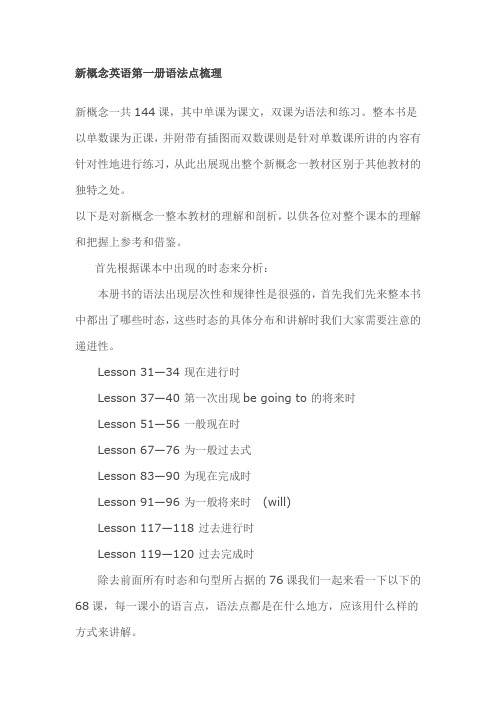
新概念英语第一册语法点梳理新概念一共144课,其中单课为课文,双课为语法和练习。
整本书是以单数课为正课,并附带有插图而双数课则是针对单数课所讲的内容有针对性地进行练习,从此出展现出整个新概念一教材区别于其他教材的独特之处。
以下是对新概念一整本教材的理解和剖析,以供各位对整个课本的理解和把握上参考和借鉴。
首先根据课本中出现的时态来分析:本册书的语法出现层次性和规律性是很强的,首先我们先来整本书中都出了哪些时态,这些时态的具体分布和讲解时我们大家需要注意的递进性。
Lesson 31—34 现在进行时Lesson 37—40 第一次出现be going to 的将来时Lesson 51—56 一般现在时Lesson 67—76 为一般过去式Lesson 83—90 为现在完成时Lesson 91—96 为一般将来时(will)Lesson 117—118 过去进行时Lesson 119—120 过去完成时除去前面所有时态和句型所占据的76课我们一起来看一下以下的68课,每一课小的语言点,语法点都是在什么地方,应该用什么样的方式来讲解。
在这里告诉学员新概念一的每一个单课的重点都是出现双课的标题和课后的练习题里面。
Lesson1—2语言点:与陌生人说话或引起别人的注意。
Excuse me. Yes? Pardon? Thank you very much.语法点:主系表结构this为主语,名词做表语1的一般疑问句以及它的肯定回答。
Is this your handbag? Yes, it is.Lesson 5—6语言点:如何介绍别人。
This is Miss Sophie Dupont. Nice to meet you.语法点:主语为第三人称单数的主系表结构。
She is French. He is German. It’s a Volvo.(L6)a/an 的使用。
Lesson 7—8语言点:如何自我介绍和相互认识。
新概念英语第一册语法

新概念英语第一册语法一.时态:一般现在时,现在进行时,一般过去时,现在完成时,一般将来时,过去进行时,过去完成时,过去将来时1.一般现在时表示一般性,经常性的动作或一般性事实。
含有be动词的句子He is a teacher.The girl is very beautiful.Tim and Jack are students.★变疑问句将be动词移到句首Is he a teacher?Is the girl very beautiful?Are Tim and Jack students?★变否定句在be动词后面加notHe is not a teacher.The girl is not very beautiful.Tim and Jack are not students.★肯定回答及否定回答Yes, he is. No, he is not.Yes, she is. No, she is not.Yes, they are. No, they are not.不含有动词的句子,即含有一般动词的句子第三人称单数及单数名词He likes books.She likes him.The dog likes bones.★变疑问句在句首加does, 动词变为原型Does he like books?Does she like him?Does the dog like bones?★变否定句在主语及动词之间加doesn’t, 动词变为原型He doesn’t li ke books.She doesn’t like him.The dog doesn’t like bones.★肯定回答及否定回答:Yes, he does. No, he doesn’t.Yes, she does. No, she doesn’tYes, it does. No, it doesn’t.注意:第三人称单数形式一般在动词后面加S,不要和名词复数混淆,变否定句或疑问句时名词复数没有任何变化。
新概念一 现在完成时

• have/has 在这里是助动词。 • Eg: I have drunk a glass of whisky. • p.s I have got a lot of money .(L79) • "have got" 就是完成时态!
变形
• 1)一般疑问句: He has loved me for 13 years. • Has he loved me for 13 years? • 回答Yes , he has. / No ,he hasn’t . • 2)否定句:把have/has 变成 haven’t/hasn’t • eg: He hasn’t loved me for 13 years . • 3)特殊:试对以下句子的划线部分提问。 • He has loved me for 13 years. • He has loved me for 13 years. • He has loved me for 13 years. • He has been to America for 2 weeks.
• 一般现在完成时通常与表示不确定的时间 副词或短语连用如 just, already, before, never, ever, twice, three times等。
• • • • • • • • •
形态:have/has+过去分词(done) p.s 过去分词的构成 1 规则动词 +en /ed eg: arrive arrived (过去式) arrived 过去分词 2 不规则动词 eg: read read read write wrote written go went gone
现在完成时
• 定义:表示已经完成的动作对现在产生或 到现在仍然延续的某个动作的影响。 • 现在完成时在汉语中常用“了”、“过” 或“已经”来表示。 • 过去时:动作已经完成 • 现在时:正在进行的动作 • He loves me. • He loved me. • He has loved me for 13 years.
新概念英语第一册第83课现在完成时

2018/1/30
现在完成时态练习题
have • 1.we_____just ______(talk)about you. talked Have visited • 2.______you_____(visit)the Great Wall yet? • 3.How long _____ _____(teach) English in have youtaught this school? • 4.He __________(work) at this school since he Has worked was 24. • 5.He_________(be)to shanghai for several times. Has been • 6.Sorry,he isn’t here. He _________(go) to Bing Has gone jing.
2018/1/30
现在完成时态练习题
• have /has been to 曾经去过某地回来了 • have /has gone to 去过某地还没回来 • have /has been in 一直待在某地
2018/1/30
现在完成时VS一般过去时
ExerciseA
1.They have already had lunch.(改为一般疑问句) Have they had lunch yet ? 2.I have stayed in Beijing for twenty years.(就划线部分提问) How long have you stayed in Beijing ? 3.Lily and Lisa have heard the news.(改为否定句) Lily and Lisa haven`t heard the news. 4.We have painted the room for 8 hours.(就划线部分提问) What have you done for 8 hours? 5.never,been,Turkey,the ,engineers ,have ,to ,before(连词成句 ) The engineers have never been to Turkey before.
(完整版)新概念英语第一册lesson85-86重点解析

Lesson 85-86学习重点:一、现在完成时和一般过去时的区别二、have been to 和have gone to 的区别三、其它主要短语和表达重点解析:一、现在完成时和一般过去时的区别1. 侧重点不同现在完成时和一般过去时所表示的动作都发生在过去,但它们所强调的重点不同:现在完成时侧重于对现在的影响;而一般过去时只说明过去某一时刻发生的动作或存在的状态,与现在没有关系。
即现在完成时侧重于现在的结果,而一般过去时侧重于动作发生的时间。
例如:I have seen the film. 我看过这部电影。
(现在我仍记得电影的内容)I saw the film three days ago.三天前我看了这部电影。
(强调是三天前,而不是别的什么时候看的电影)Mr. Green has bought a new computer.格林先生买了一台新电脑。
(着重点是格林先生现在有了一台新电脑)Mr. Green bought a new computer yesterday.格林先生昨天买了一台新电脑。
(强调的是格林先生买新电脑的时间是昨天)2. 时间状语不同现在完成时常与already, yet, just, ever, never等副词以及“for+段时间”, “since+过去时间/从句”等时间状语连用;而一般过去时则常与“段时间+ago”, just now, yesterday, last week 等表示确定的过去时间的状语连用。
例如:She has lived here since two years ago.她两年前就住在这里了。
(暗含她可能还会在这里住下去)She lived here two years ago. 两年前她住在这里。
(暗含她曾经住过,但现在不在这里了)He has been in the company for three years.他在这家公司已经三年了。
(现在可能还在这家公司)Tom wrote a letter to his parents last night. 昨晚汤姆给他的父母写了封信。
新概念第一册第85课现在完成时

一般现在时(对这部电影的一般性评价)
16
仿照例句: 我已经读了这本书。我是在昨天读的。这是本旧 书,但是很有趣。
I have already read this book.
I read it yesterday.
It’s an old book, but it’s interesting.
17
1
含规则动词的现在完成时句型
句型: I have been to… I have gone to… 副词: ever, never
contents
2
复习
步骤
课文讲解
课堂练习
3
我已经吃过午饭了. I’ve already had lunch. 他们今年已经度假了. They’ve already had holiday this year. 她已经吃过牛肉了. She has already had beef.
6
Paris Cinema Film Movie Beautiful Beauty n.
7
City Never Ever Just already
8
★ 回顾现在完成时:
主语+have/ has + 动词的过去分词
表示过去的动作对现在的影响
I have had breakfast.
影响.
already, just ( 肯定句中); never(表否 定); ever(疑问句和 否定句中)
Have you just been to the cinema?
你刚去过电影院吗? I’ve already seen the film.
我已经看过那部电影了。
新概念英语第一册全部语法
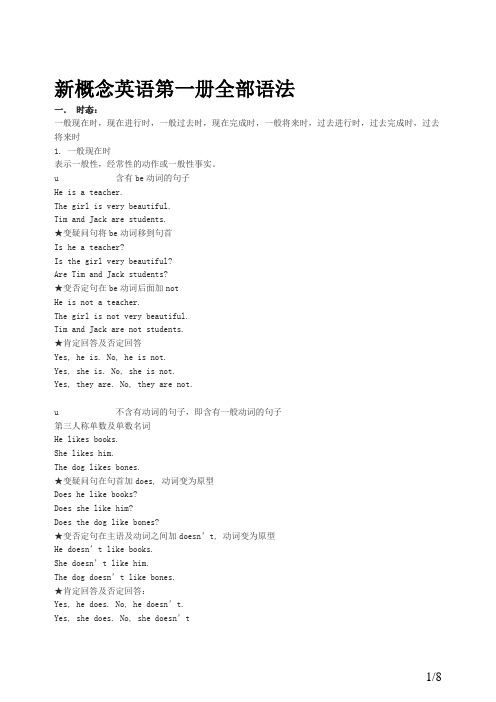
新概念英语第一册全部语法一.时态:一般现在时,现在进行时,一般过去时,现在完成时,一般将来时,过去进行时,过去完成时,过去将来时1. 一般现在时表示一般性,经常性的动作或一般性事实。
u 含有be动词的句子He is a teacher.The girl is very beautiful.Tim and Jack are students.★变疑问句将be动词移到句首Is he a teacher?Is the girl very beautiful?Are Tim and Jack students?★变否定句在be动词后面加notHe is not a teacher.The girl is not very beautiful.Tim and Jack are not students.★肯定回答及否定回答Yes, he is. No, he is not.Yes, she is. No, she is not.Yes, they are. No, they are not.u 不含有动词的句子,即含有一般动词的句子第三人称单数及单数名词He likes books.She likes him.The dog likes bones.★变疑问句在句首加does, 动词变为原型Does he like books?Does she like him?Does the dog like bones?★变否定句在主语及动词之间加doesn’t, 动词变为原型He doesn’t like books.She doesn’t like him.The dog doesn’t like bones.★肯定回答及否定回答:Yes, he does. No, he doesn’t.Yes, she does. No, she doesn’tYes, it does. No, it doesn’t.注意:第三人称单数形式一般在动词后面加S,不要和名词复数混淆,变否定句或疑问句时名词复数没有任何变化。
新概念英语第一册语法规则

新概念英语第一册语法规则新概念英语第一册语法规则:时态1、一般现在时:(除主语第三人称)谓语动词都使用动词原形。
常与副词“always”,“never”,“often”,“seldom”,“usually”,“every”,“day”等连用。
2、现在实行时:表示现在正在实行的动作。
语法:Be+动词现在分词3、现在完成时:表动作发生在过去,但与现在相关系。
即用一个发生在过去的动作来说明现在的情况。
语法:Have+动词过去分词4、一般过去时:表过去某个时间发生的动作或存有的状态,也表示过去常发生的动作。
语法1(be动词):主语+be动词过去式语法2:主语+动词过去式5、过去实行时:表某一时刻或某一段时间内正在实行或持续实行的作动。
语法:Be动词过去式+动词现在分词6、过去完成时:表在过去某一时间或动作以前己经完成的动作。
语法:Had+动词过去分词构成7、一般将来时:表将来某个时间要发生的动作或存有的状态,也表将来经常或反复发生的动作。
语法1:Will(Shall)+动词原形语法2:Be+going go+动词原形8、过去将来时:表从过去某一时间看将要发生的动作或存有的状态。
语法1:Would(Should)+动词原形语法2:Be动词过去式+going to+动词原形新概念英语第一册语法规则:从句一、宾语从句:宾语从句是由一个完整的句子构成,充当宾语修饰谓语动词、介词和、限定动词和某些形容词的宾语。
如果从句部份是一个陈述句或是一个一般疑句(一般疑问句如果做为从句则需变为陈述句)则通常使用引导词“that”、“whether”、“if”加上从句部份来构成宾语从句。
如果从句部份是一个特殊疑问句,而把特殊疑问词做引导词在加上由一般疑问句变来的陈述句来构成宾语从句。
例1:由that、whether或if引导的宾语从句。
1、She saw that her was sleeping. 她看见他在睡觉(修饰谓语动词“saw”)。
新概念英语第一册全部语法
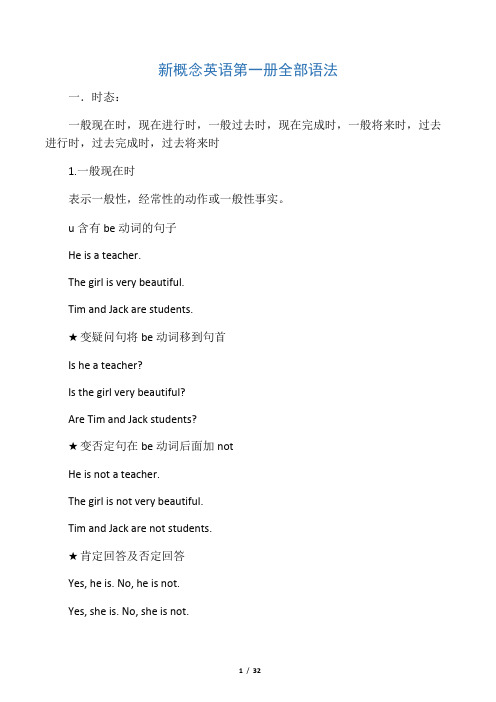
新概念英语第一册全部语法一.时态:一般现在时,现在进行时,一般过去时,现在完成时,一般将来时,过去进行时,过去完成时,过去将来时1.一般现在时表示一般性,经常性的动作或一般性事实。
u含有be动词的句子He is a teacher.The girl is very beautiful.Tim and Jack are students.★变疑问句将be动词移到句首Is he a teacher?Is the girl very beautiful?Are Tim and Jack students?★变否定句在be动词后面加notHe is not a teacher.The girl is not very beautiful.Tim and Jack are not students.★肯定回答及否定回答Yes, he is. No, he is not.Yes, she is. No, she is not.Yes, they are. No, they are not.u不含有动词的句子,即含有一般动词的句子第三人称单数及单数名词He likes books.She likes him.The dog likes bones.★变疑问句在句首加does,动词变为原型Does he like books?Does she like him?Does the dog like bones?★变否定句在主语及动词之间加doesn’t,动词变为原型He doesn’t like books.S he doesn’t like him.The dog doesn’t like bones.★肯定回答及否定回答:Yes, he does. No, he doesn’t.Yes, she does. No, she doesn’t1/8Yes, it does. No, it doesn’t.注意:第三人称单数形式一般在动词后面加S,不要和名词复数混淆,变否定句或疑问句时名词复数没有任何变化。
新概念英语第一册语法知识点
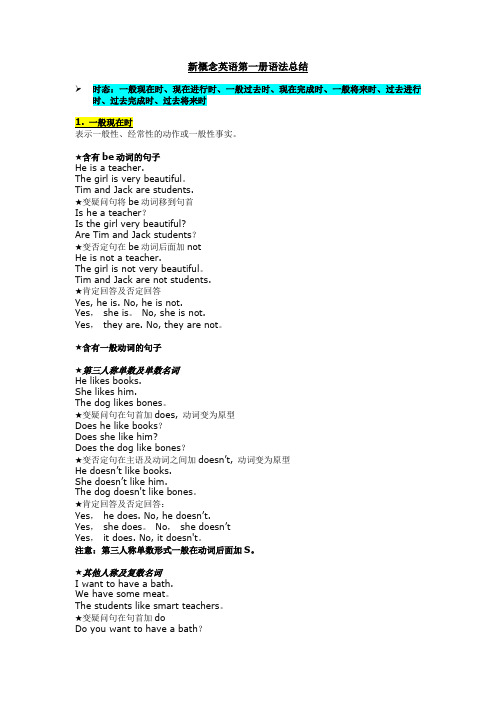
新概念英语第一册语法总结➢时态:一般现在时、现在进行时、一般过去时、现在完成时、一般将来时、过去进行时、过去完成时、过去将来时★含有be动词的句子He is a teacher.The girl is very beautiful。
Tim and Jack are students.★变疑问句将be动词移到句首Is he a teacher?Is the girl very beautiful?Are Tim and Jack students?★变否定句在be动词后面加notHe is not a teacher.The girl is not very beautiful。
Tim and Jack are not students.★肯定回答及否定回答Yes, he is. No, he is not.Yes,she is。
No, she is not.Yes,they are. No, they are not。
★含有一般动词的句子★第三人称单数及单数名词He likes books.She likes him.The dog likes bones。
★变疑问句在句首加does, 动词变为原型Does he like books?Does she like him?Does the dog like bones?★变否定句在主语及动词之间加doesn’t, 动词变为原型He doesn’t like books.She doesn’t like him.The dog doesn't like bones。
★肯定回答及否定回答:Yes,he does. No, he doesn’t.Yes,she does。
No,she doesn’tYes,it does. No, it doesn't。
注意:第三人称单数形式一般在动词后面加S。
★其他人称及复数名词I want to have a bath.We have some meat。
(完整版)最全新概念英语第一册语法汇总,文档

时态:大凡现在时,现在进行时,现在完成时,大凡过去时,过去进行时,过去完成时,大凡将来时,过去将来时。
性:在分、的去式和去分。
形容、副的比与最高。
助、情、半情的使用。
不定式。
反身代、不定代。
分外疑。
句式:句、并列句、复合句〔定从句、状从句、从句〕。
:被。
构: There be构。
序:倒装。
〔新看法英一册1-144的所不搭配短〕I beg your pardon 您在重复〔〕一遍Nice to meet you〔too〕〔我也〕很高到你Look at 看⋯⋯ How do you do你好 Be careful小心A loaf of 一个 A bar of 一条 A bottle of 一瓶 A pound of 一磅 Half a pound of 半磅 A quarter of 四分之一 A tin of 一听 Hurry up 快点 Next door 近邻 Black coffee 不加牛奶的咖啡White coffee 加牛奶的咖啡 Come home from school 放学回家Come home from work 下班回家 At the moment 现在 What’ s the time?几点? Come upstairs上楼 Come downstairs下楼Hundreds of 数⋯以百的⋯ On the way home在回家的途中This morning 今天清早 This afternoon 今天下午This evening今天夜晚 tonight 今天夜里Yesterday morning 昨天清早 Yesterday afternoon 昨天下午Yesterday evening昨天夜晚 Last night 昨天夜里The day before yesterday in the morning前天清早The day before yesterday in the afternoon 前天下午The day before yesterday in the evening前天夜晚The night before last 前天夜 A low mark 分数很底 A high mark 分数很高She said to herself她心中暗想 The way to 到⋯⋯的走法In fashion 流行的,髦的I ’ m afraid我恐⋯怕⋯I ’ m sure我⋯确信,我必然⋯ A lot of多〔用于必然句〕At all 毫、更本、一点也不Going on holiday 度假Have been to 到⋯⋯ All the time素来,始Have been to 到⋯⋯ Drive into 撞倒⋯⋯For sale 供销售、销售 Have the last word 最后决定、最后才算英.国皇家空Return ticket 往返票Next door to与⋯相,在⋯近邻In five hours’在time五小此后。
新概念一现在完成时
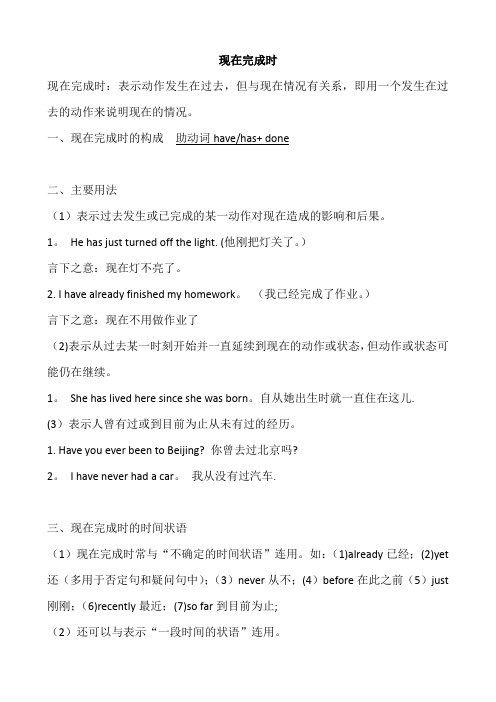
现在完成时现在完成时:表示动作发生在过去,但与现在情况有关系,即用一个发生在过去的动作来说明现在的情况。
一、现在完成时的构成助动词have/has+ done二、主要用法(1)表示过去发生或已完成的某一动作对现在造成的影响和后果。
1。
He has just turned off the light. (他刚把灯关了。
)言下之意:现在灯不亮了。
2. I have already finished my homework。
(我已经完成了作业。
)言下之意:现在不用做作业了(2)表示从过去某一时刻开始并一直延续到现在的动作或状态,但动作或状态可能仍在继续。
1。
She has lived here since she was born。
自从她出生时就一直住在这儿. (3)表示人曾有过或到目前为止从未有过的经历。
1. Have you ever been to Beijing? 你曾去过北京吗?2。
I have never had a car。
我从没有过汽车.三、现在完成时的时间状语(1)现在完成时常与“不确定的时间状语”连用。
如:(1)already已经;(2)yet 还(多用于否定句和疑问句中);(3)never从不;(4)before在此之前(5)just 刚刚;(6)recently最近;(7)so far到目前为止;(2)还可以与表示“一段时间的状语”连用。
Ⅰsince1。
since+时间点I have worked here since 2006。
2006年以来,我一直在这里工作。
2。
since+一段时间+agoI have known Lily since 2 years ago.自从两年前,我就认识了lily.Ⅱ for+一段时间(two days\two weeks\three years)表示持续……时间She has worked here for 3 years。
她在这里工作3年了.四、现在完成时与一般过去时的用法比较(1)一般过去时表示过去发生的动作或单纯叙述过去的事情,强调动作发生在过去,和现在没有关系。
- 1、下载文档前请自行甄别文档内容的完整性,平台不提供额外的编辑、内容补充、找答案等附加服务。
- 2、"仅部分预览"的文档,不可在线预览部分如存在完整性等问题,可反馈申请退款(可完整预览的文档不适用该条件!)。
- 3、如文档侵犯您的权益,请联系客服反馈,我们会尽快为您处理(人工客服工作时间:9:00-18:30)。
新概念第一册语法讲解:现在完成时
现在完成时
构成:主语+助动词have, has+过去分词
用法:
1)表示过去发生的和现在有某种联系的动作,常和just, usually, already, since等时间副词连用。
I have just had lunch. (饱了,不用再吃了。
)
He has had a cup of tea.(不渴了,不用再喝。
)
They have already had their holiday. (不能再度假了。
)
The boy has already read the book. (已经知道书的内容了,不
用再看了。
)
2)询问别人是否做过某事一般用现在完成时:
Have you finished your homework?
Have you been to Beijing?
Have he seen the film?
3)表示开始于过去并持续到现在的动作
I have lived in Beijing for twenty years.
I have worked for this school for 1 year.
4)表示一种经历,经验:去过…地方,做过…事情,经历过…事情
I have never had a bath.
I have never seen a film.
I have never been to cinema.
I have ever been to Paris.
Have been to表示去过,have gone to 表示去了
I have been to London.(人已经回来)
He has gone to London.(人还在那里)
5)表示一种结果,一般不和时间副词联用
I have lost my pen.
I have hurt myself.
He has become a teacher.
She has broken my heart.
句型变化:
★变疑问句将助动词移到句首,变否定句在助动词后面加not. Have you lost your pen? I have not lost my pen.
★肯定回答及否定回答
Yes, I have. / No, I have not.
★特殊疑问句
What have you done?
What has he done?
一般过去时与现在完成时的区别:
凡是有明确的表示过去的时间状语的句子为过去时。
注意:有些动词表示的动作有一个终点,不能再延续,所以不能和表示一段时间状语连用。
错:I’ve left Beijing for 3 days.
对:I left Beijing 3 days ago. I have been away from being for 3 days.。
